
tensorrtllm_backend
The Triton TensorRT-LLM Backend
Stars: 814
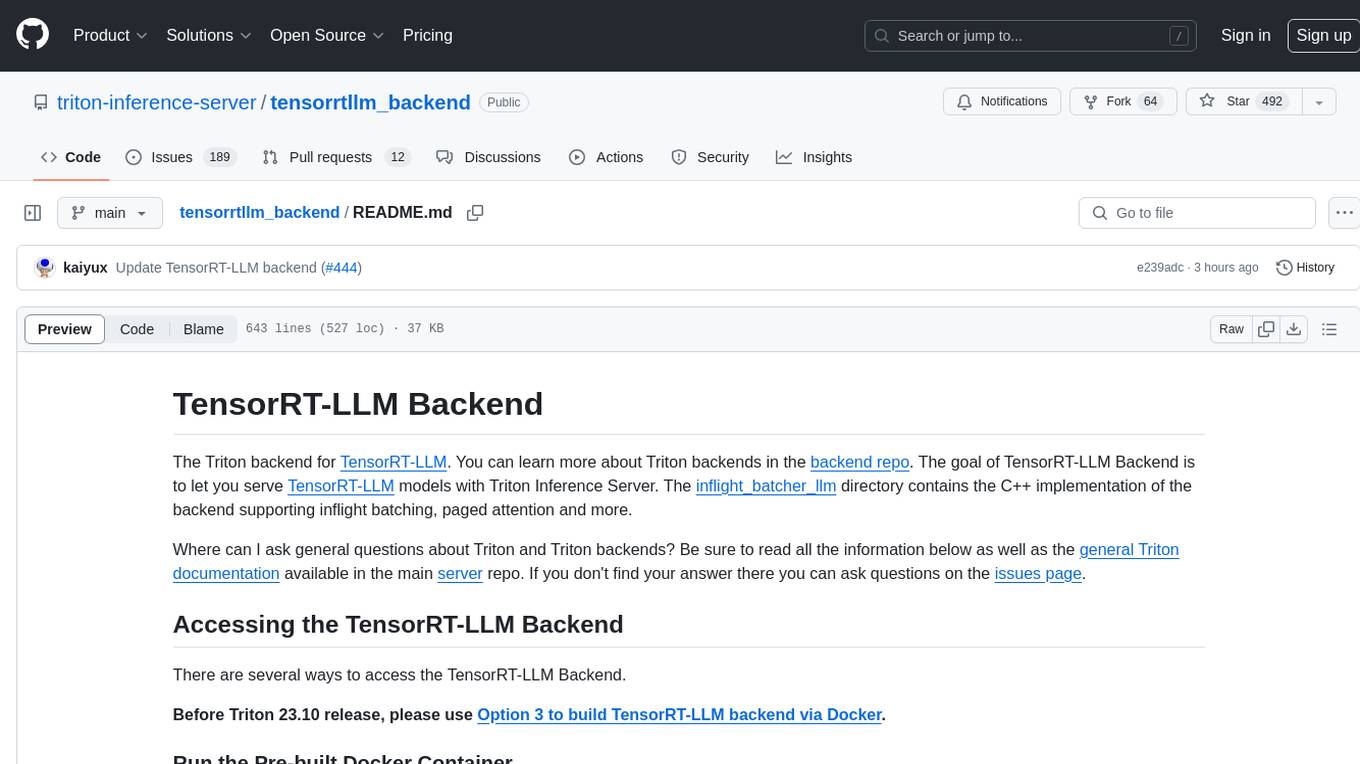
The TensorRT-LLM Backend is a Triton backend designed to serve TensorRT-LLM models with Triton Inference Server. It supports features like inflight batching, paged attention, and more. Users can access the backend through pre-built Docker containers or build it using scripts provided in the repository. The backend can be used to create models for tasks like tokenizing, inferencing, de-tokenizing, ensemble modeling, and more. Users can interact with the backend using provided client scripts and query the server for metrics related to request handling, memory usage, KV cache blocks, and more. Testing for the backend can be done following the instructions in the 'ci/README.md' file.
README:
The Triton backend for TensorRT-LLM. You can learn more about Triton backends in the backend repo. The goal of TensorRT-LLM Backend is to let you serve TensorRT-LLM models with Triton Inference Server. The inflight_batcher_llm directory contains the C++ implementation of the backend supporting inflight batching, paged attention and more.
Where can I ask general questions about Triton and Triton backends? Be sure to read all the information below as well as the general Triton documentation available in the main server repo. If you don't find your answer there you can ask questions on the issues page.
-
TensorRT-LLM Backend
- Table of Contents
- Getting Started
- Building from Source
- Supported Models
- Model Config
- Model Deployment
- Launch Triton server within Slurm based clusters
- Triton Metrics
- Benchmarking
- Testing the TensorRT-LLM Backend
Below is an example of how to serve a TensorRT-LLM model with the Triton TensorRT-LLM Backend on a 4-GPU environment. The example uses the GPT model from the TensorRT-LLM repository with the NGC Triton TensorRT-LLM container. Make sure you are cloning the same version of TensorRT-LLM backend as the version of TensorRT-LLM in the container. Please refer to the support matrix to see the aligned versions.
In this example, we will use Triton 24.07 with TensorRT-LLM v0.11.0.
Launch Triton docker container nvcr.io/nvidia/tritonserver:<xx.yy>-trtllm-python-py3
with TensorRT-LLM backend.
Make an engines folder outside docker to reuse engines for future runs. Make
sure to replace the <xx.yy> with the version of Triton that you want to use.
docker run --rm -it --net host --shm-size=2g \
--ulimit memlock=-1 --ulimit stack=67108864 --gpus all \
-v </path/to/engines>:/engines \
nvcr.io/nvidia/tritonserver:24.07-trtllm-python-py3You can skip this step if you already have the engines ready. Follow the guide in TensorRT-LLM repository for more details on how to to prepare the engines for all the supported models. You can also check out the tutorials to see more examples with serving TensorRT-LLM models.
cd /app/tensorrt_llm/examples/gpt
# Download weights from HuggingFace Transformers
rm -rf gpt2 && git clone https://huggingface.co/gpt2-medium gpt2
pushd gpt2 && rm pytorch_model.bin model.safetensors && wget -q https://huggingface.co/gpt2-medium/resolve/main/pytorch_model.bin && popd
# Convert weights from HF Tranformers to TensorRT-LLM checkpoint
python3 convert_checkpoint.py --model_dir gpt2 \
--dtype float16 \
--tp_size 4 \
--output_dir ./c-model/gpt2/fp16/4-gpu
# Build TensorRT engines
trtllm-build --checkpoint_dir ./c-model/gpt2/fp16/4-gpu \
--gpt_attention_plugin float16 \
--remove_input_padding enable \
--kv_cache_type paged \
--gemm_plugin float16 \
--output_dir /engines/gpt/fp16/4-gpuSee here for more details on the parameters.
Next, create the model repository that will be used by the Triton server. The models can be found in the all_models folder. The folder contains two groups of models:
-
gpt: Using TensorRT-LLM pure Python runtime. -
inflight_batcher_llm`: Using the C++ TensorRT-LLM backend with the executor API, which includes the latest features including inflight batching.
There are five models in all_models/inflight_batcher_llm that will be used in this example:
| Model | Description |
|---|---|
ensemble |
This model is used to chain the preprocessing, tensorrt_llm and postprocessing models together. |
preprocessing |
This model is used for tokenizing, meaning the conversion from prompts(string) to input_ids(list of ints). |
tensorrt_llm |
This model is a wrapper of your TensorRT-LLM model and is used for inferencing. Input specification can be found here |
postprocessing |
This model is used for de-tokenizing, meaning the conversion from output_ids(list of ints) to outputs(string). |
tensorrt_llm_bls |
This model can also be used to chain the preprocessing, tensorrt_llm and postprocessing models together. |
To learn more about ensemble and BLS models, please see the Ensemble Models and Business Logic Scripting documentation.
To learn more about the benefits and the limitations of using the BLS model, please see the model config section.
mkdir /triton_model_repo
cp -r /app/all_models/inflight_batcher_llm/* /triton_model_repo/Use the script to fill in the parameters in the model configuration files. For optimal performance or custom parameters, please refer to perf_best_practices. For more details on the model configuration and the parameters that can be modified, please refer to the model config section.
ENGINE_DIR=/engines/gpt/fp16/4-gpu
TOKENIZER_DIR=/app/tensorrt_llm/examples/gpt/gpt2
MODEL_FOLDER=/triton_model_repo
TRITON_MAX_BATCH_SIZE=4
INSTANCE_COUNT=1
MAX_QUEUE_DELAY_MS=0
MAX_QUEUE_SIZE=0
FILL_TEMPLATE_SCRIPT=/app/tools/fill_template.py
DECOUPLED_MODE=false
LOGITS_DATATYPE=TYPE_FP32
python3 ${FILL_TEMPLATE_SCRIPT} -i ${MODEL_FOLDER}/ensemble/config.pbtxt triton_max_batch_size:${TRITON_MAX_BATCH_SIZE},logits_datatype:${LOGITS_DATATYPE}
python3 ${FILL_TEMPLATE_SCRIPT} -i ${MODEL_FOLDER}/preprocessing/config.pbtxt tokenizer_dir:${TOKENIZER_DIR},triton_max_batch_size:${TRITON_MAX_BATCH_SIZE},preprocessing_instance_count:${INSTANCE_COUNT}
python3 ${FILL_TEMPLATE_SCRIPT} -i ${MODEL_FOLDER}/tensorrt_llm/config.pbtxt triton_backend:tensorrtllm,triton_max_batch_size:${TRITON_MAX_BATCH_SIZE},decoupled_mode:${DECOUPLED_MODE},engine_dir:${ENGINE_DIR},max_queue_delay_microseconds:${MAX_QUEUE_DELAY_MS},batching_strategy:inflight_fused_batching,max_queue_size:${MAX_QUEUE_SIZE},encoder_input_features_data_type:TYPE_FP16,logits_datatype:${LOGITS_DATATYPE}
python3 ${FILL_TEMPLATE_SCRIPT} -i ${MODEL_FOLDER}/postprocessing/config.pbtxt tokenizer_dir:${TOKENIZER_DIR},triton_max_batch_size:${TRITON_MAX_BATCH_SIZE},postprocessing_instance_count:${INSTANCE_COUNT}
python3 ${FILL_TEMPLATE_SCRIPT} -i ${MODEL_FOLDER}/tensorrt_llm_bls/config.pbtxt triton_max_batch_size:${TRITON_MAX_BATCH_SIZE},decoupled_mode:${DECOUPLED_MODE},bls_instance_count:${INSTANCE_COUNT},logits_datatype:${LOGITS_DATATYPE}NOTE: It is recommended to match the number of pre/post_instance_counts with triton_max_batch_size for better performance.
Now, you're ready to launch the Triton server with the TensorRT-LLM model.
Use the launch_triton_server.py script. This launches multiple instances of tritonserver with MPI.
# 'world_size' is the number of GPUs you want to use for serving. This should
# be aligned with the number of GPUs used to build the TensorRT-LLM engine.
python3 /app/scripts/launch_triton_server.py --world_size=4 --model_repo=${MODEL_FOLDER}You should see the following logs when the server is successfully deployed.
...
I0503 22:01:25.210518 1175 grpc_server.cc:2463] Started GRPCInferenceService at 0.0.0.0:8001
I0503 22:01:25.211612 1175 http_server.cc:4692] Started HTTPService at 0.0.0.0:8000
I0503 22:01:25.254914 1175 http_server.cc:362] Started Metrics Service at 0.0.0.0:8002To stop Triton Server inside the container, run:
pkill tritonserverUsing the generate endpoint
The general format of the generate endpoint:
curl -X POST localhost:8000/v2/models/${MODEL_NAME}/generate -d '{"{PARAM1_KEY}": "{PARAM1_VALUE}", ... }'In the case of the models used in this example, you can replace MODEL_NAME with
ensemble or tensorrt_llm_bls. Examining the ensemble and tensorrt_llm_bls
model's config.pbtxt file, you can see that 4 parameters are required to
generate a response for this model:
- text_input: Input text to generate a response from
- max_tokens: The number of requested output tokens
- bad_words: A list of bad words (can be empty)
- stop_words: A list of stop words (can be empty)
Therefore, we can query the server in the following way:
- if using the ensemble model
curl -X POST localhost:8000/v2/models/ensemble/generate -d '{"text_input": "What is machine learning?", "max_tokens": 20, "bad_words": "", "stop_words": ""}'- if using the tensorrt_llm_bls model
curl -X POST localhost:8000/v2/models/tensorrt_llm_bls/generate -d '{"text_input": "What is machine learning?", "max_tokens": 20, "bad_words": "", "stop_words": ""}'Which should return a result similar to (formatted for readability):
{
"model_name": "ensemble",
"model_version": "1",
"sequence_end": false,
"sequence_id": 0,
"sequence_start": false,
"text_output": "What is machine learning?\n\nMachine learning is a method of learning by using machine learning algorithms to solve problems.\n\n"
}You can refer to the client scripts in the inflight_batcher_llm/client to see how to send requests via Python scripts.
Below is an example of using
inflight_batcher_llm_client
to send requests to the tensorrt_llm model.
pip3 install tritonclient[all]
INFLIGHT_BATCHER_LLM_CLIENT=/app/inflight_batcher_llm/client/inflight_batcher_llm_client.py
python3 ${INFLIGHT_BATCHER_LLM_CLIENT} --request-output-len 200 --tokenizer-dir ${TOKENIZER_DIR}The result should be similar to the following:
Using pad_id: 50256
Using end_id: 50256
Input sequence: [28524, 287, 5093, 12, 23316, 4881, 11, 30022, 263, 8776, 355, 257]
Got completed request
Input: Born in north-east France, Soyer trained as a
Output beam 0: chef before moving to London in the early 1990s. He has since worked in restaurants in London, Paris, Milan and New York.
He is married to the former model and actress, Anna-Marie, and has two children, a daughter, Emma, and a son, Daniel.
Soyer's wife, Anna-Marie, is a former model and actress.
He is survived by his wife, Anna-Marie, and their two children, Daniel and Emma.
Soyer was born in the north-east of France, and moved to London in the early 1990s.
He was a chef at the London restaurant, The Bistro, before moving to New York in the early 2000s.
He was a regular at the restaurant, and was also a regular at the restaurant, The Bistro, before moving to London in the early 2000s.
Soyer was a regular at the restaurant, and was
Output sequence: [28524, 287, 5093, 12, 23316, 4881, 11, 30022, 263, 8776, 355, 257, 21221, 878, 3867, 284, 3576, 287, 262, 1903, 6303, 82, 13, 679, 468, 1201, 3111, 287, 10808, 287, 3576, 11, 6342, 11, 21574, 290, 968, 1971, 13, 198, 198, 1544, 318, 6405, 284, 262, 1966, 2746, 290, 14549, 11, 11735, 12, 44507, 11, 290, 468, 734, 1751, 11, 257, 4957, 11, 18966, 11, 290, 257, 3367, 11, 7806, 13, 198, 198, 50, 726, 263, 338, 3656, 11, 11735, 12, 44507, 11, 318, 257, 1966, 2746, 290, 14549, 13, 198, 198, 1544, 318, 11803, 416, 465, 3656, 11, 11735, 12, 44507, 11, 290, 511, 734, 1751, 11, 7806, 290, 18966, 13, 198, 198, 50, 726, 263, 373, 4642, 287, 262, 5093, 12, 23316, 286, 4881, 11, 290, 3888, 284, 3576, 287, 262, 1903, 6303, 82, 13, 198, 198, 1544, 373, 257, 21221, 379, 262, 3576, 7072, 11, 383, 347, 396, 305, 11, 878, 3867, 284, 968, 1971, 287, 262, 1903, 4751, 82, 13, 198, 198, 1544, 373, 257, 3218, 379, 262, 7072, 11, 290, 373, 635, 257, 3218, 379, 262, 7072, 11, 383, 347, 396, 305, 11, 878, 3867, 284, 3576, 287, 262, 1903, 4751, 82, 13, 198, 198, 50, 726, 263, 373, 257, 3218, 379, 262, 7072, 11, 290, 373]You can also stop the generation process early by using the --stop-after-ms
option to send a stop request after a few milliseconds:
python3 ${INFLIGHT_BATCHER_LLM_CLIENT} --stop-after-ms 200 --request-output-len 200 --request-id 1 --tokenizer-dir ${TOKENIZER_DIR}You will find that the generation process is stopped early and therefore the number of generated tokens is lower than 200. You can have a look at the client code to see how early stopping is achieved.
If you want to get context logits and/or generation logits, you need to enable
--gather_context_logits and/or --gather_generation_logits when building the
engine (or --gather_all_token_logits to enable both at the same time). For
more setting details about these two flags, please refer to
build.py
or
gpt_runtime.
After launching the server, you could get the output of logits by passing the
corresponding parameters --return-context-logits and/or
--return-generation-logits in the client scripts
(end_to_end_grpc_client.py
and
inflight_batcher_llm_client.py).
For example:
python3 ${INFLIGHT_BATCHER_LLM_CLIENT} --request-output-len 20 --tokenizer-dir ${TOKENIZER_DIR} --return-context-logits --return-generation-logitsThe result should be similar to the following:
Input sequence: [28524, 287, 5093, 12, 23316, 4881, 11, 30022, 263, 8776, 355, 257]
Got completed request
Input: Born in north-east France, Soyer trained as a
Output beam 0: has since worked in restaurants in London,
Output sequence: [21221, 878, 3867, 284, 3576, 287, 262, 1903, 6303, 82, 13, 679, 468, 1201, 3111, 287, 10808, 287, 3576, 11]
context_logits.shape: (1, 12, 50257)
context_logits: [[[ -65.9822 -62.267445 -70.08991 ... -76.16964 -78.8893
-65.90678 ]
[-103.40278 -102.55243 -106.119026 ... -108.925415 -109.408585
-101.37687 ]
[ -63.971176 -64.03466 -67.58809 ... -72.141235 -71.16892
-64.23846 ]
...
[ -80.776375 -79.1815 -85.50916 ... -87.07368 -88.02817
-79.28435 ]
[ -10.551408 -7.786484 -14.524468 ... -13.805856 -15.767286
-7.9322424]
[-106.33096 -105.58956 -111.44852 ... -111.04858 -111.994194
-105.40376 ]]]
generation_logits.shape: (1, 1, 20, 50257)
generation_logits: [[[[-106.33096 -105.58956 -111.44852 ... -111.04858 -111.994194
-105.40376 ]
[ -77.867424 -76.96638 -83.119095 ... -87.82542 -88.53957
-75.64877 ]
[-136.92282 -135.02484 -140.96051 ... -141.78284 -141.55045
-136.01668 ]
...
[-100.03721 -98.98237 -105.25507 ... -108.49254 -109.45882
-98.95136 ]
[-136.78777 -136.16165 -139.13437 ... -142.21495 -143.57468
-134.94667 ]
[ 19.222942 19.127287 14.804495 ... 10.556551 9.685863
19.625107]]]]The TRT-LLM backend supports requests with batch size greater than one. When
sending a request with a batch size greater than one, the TRT-LLM backend will
return multiple batch size 1 responses, where each response will be associated
with a given batch index. An output tensor named batch_index is associated
with each response to indicate which batch index this response corresponds to.
The client script
end_to_end_grpc_client.py
demonstrates how a client can send requests with batch size > 1 and consume the
responses returned from Triton. When passing --batch-inputs to the client
script, the client will create a request with multiple prompts, and use the
batch_index output tensor to associate the responses to the original prompt.
For example one could run:
python3 /app/inflight_batcher_llm/client/end_to_end_grpc_client.py -o 5 -p '["This is a test","I want you to","The cat is"]' --batch-inputs
to send a request with a batch size of 3 to the Triton server.
Please refer to the build.md for more details on how to build the Triton TRT-LLM container from source.
Only a few examples are listed here. For all the supported models, please refer to the support matrix.
-
LLaMa
-
Gemma
-
Mistral
-
Multi-modal
-
Encoder-Decoder
Please refer to the model config for more details on the model configuration.
TensorRT-LLM backend relies on MPI to coordinate the execution of a model across multiple GPUs and nodes. Currently, there are two different modes supported to run a model across multiple GPUs, Leader Mode and Orchestrator Mode.
Note: This is different from the model multi-instance support from Triton Server which allows multiple instances of a model to be run on the same or different GPUs. For more information on Triton Server multi-instance support, please refer to the Triton model config documentation.
In leader mode, TensorRT-LLM backend spawns one Triton Server process for every
GPU. The process with rank 0 is the leader process. Other Triton Server processes,
do not return from the TRITONBACKEND_ModelInstanceInitialize call to avoid
port collision and allowing the other processes to receive requests.
The overview of this mode is described in the diagram below:
This mode is friendly with slurm deployments since it doesn't use MPI_Comm_spawn.
In orchestrator mode, the TensorRT-LLM backend spawns a single Triton Server
process that acts as an orchestrator and spawns one Triton Server process for
every GPU that each model requires. This mode is mainly used when serving
multiple models with TensorRT-LLM backend. In this mode, the MPI world size
must be one as TRT-LLM backend will automatically create new workers as needed.
The overview of this mode is described in the diagram below:
Since this mode uses MPI_Comm_spawn, it might not work properly with slurm deployments. Additionally, this currently only works for single node deployments.
Please refer to Running Multiple Instances of the LLaMa Model for more information on running multiple instances of LLaMa model in different configurations.
Check out the Multi-Node Generative AI w/ Triton Server and TensorRT-LLM tutorial for Triton Server and TensorRT-LLM multi-node deployment.
Tensor Parallelism, Pipeline Parallelism and Expert parallelism are supported in TensorRT-LLM.
See the models in the examples folder for more details on how to build the engines with tensor parallelism, pipeline parallelism and expert parallelism.
Some examples are shown below:
- Build LLaMA v3 70B using 4-way tensor parallelism and 2-way pipeline parallelism.
python3 convert_checkpoint.py --model_dir ./tmp/llama/70B/hf/ \
--output_dir ./tllm_checkpoint_8gpu_tp4_pp2 \
--dtype float16 \
--tp_size 4 \
--pp_size 2
trtllm-build --checkpoint_dir ./tllm_checkpoint_8gpu_tp4_pp2 \
--output_dir ./tmp/llama/70B/trt_engines/fp16/8-gpu/ \
--gemm_plugin auto- Build Mixtral8x22B with tensor parallelism and expert parallelism
python3 ../llama/convert_checkpoint.py --model_dir ./Mixtral-8x22B-v0.1 \
--output_dir ./tllm_checkpoint_mixtral_8gpu \
--dtype float16 \
--tp_size 8 \
--moe_tp_size 2 \
--moe_ep_size 4
trtllm-build --checkpoint_dir ./tllm_checkpoint_mixtral_8gpu \
--output_dir ./trt_engines/mixtral/tp2ep4 \
--gemm_plugin float16See the doc to learn more about how TensorRT-LLM expert parallelism works in Mixture of Experts (MoE).
See the MIG tutorial for more details on how to run TRT-LLM models and Triton with MIG.
The scheduler policy helps the batch manager adjust how requests are scheduled
for execution. There are two scheduler policies supported in TensorRT-LLM,
MAX_UTILIZATION and GUARANTEED_NO_EVICT. See the
batch manager design
to learn more about how scheduler policies work. You can specify the scheduler
policy via the batch_scheduler_policy parameter in the
model config of tensorrt_llm model.
See the KV Cache section for more details on how TensorRT-LLM supports KV cache. Also, check out the KV Cache Reuse documentation to learn more about how to enable KV cache reuse when building the TRT-LLM engine. Parameters for KV cache can be found in the model config of tensorrt_llm model.
TensorRT-LLM supports various decoding modes, including top-k, top-p, top-k top-p, beam search Medusa, ReDrafter, Lookahead and Eagle. See the Sampling Parameters section to learn more about top-k, top-p, top-k top-p and beam search decoding. Please refer to the speculative decoding documentation for more details on Medusa, ReDrafter, Lookahead and Eagle.
Parameters for decoding modes can be found in the model config of tensorrt_llm model.
See the Speculative Decoding documentation to learn more about how TensorRT-LLM supports speculative decoding to improve the performance. The parameters for speculative decoding can be found in the model config of tensorrt_llm_bls model.
For more details on how to use chunked context, please refer to the Chunked Context section. Parameters for chunked context can be found in the model config of tensorrt_llm model.
Check out the Quantization Guide to learn more about how to install the quantization toolkit and quantize TensorRT-LLM models. Also, check out the blog post Speed up inference with SOTA quantization techniques in TRT-LLM to learn more about how to speed up inference with quantization.
Refer to lora.md for more details on how to use LoRa with TensorRT-LLM and Triton.
tensorrt_llm_triton.sub
#!/bin/bash
#SBATCH -o logs/tensorrt_llm.out
#SBATCH -e logs/tensorrt_llm.error
#SBATCH -J <REPLACE WITH YOUR JOB's NAME>
#SBATCH -A <REPLACE WITH YOUR ACCOUNT's NAME>
#SBATCH -p <REPLACE WITH YOUR PARTITION's NAME>
#SBATCH --nodes=1
#SBATCH --ntasks-per-node=8
#SBATCH --time=00:30:00
sudo nvidia-smi -lgc 1410,1410
srun --mpi=pmix \
--container-image triton_trt_llm \
--container-workdir /tensorrtllm_backend \
--output logs/tensorrt_llm_%t.out \
bash /tensorrtllm_backend/tensorrt_llm_triton.shtensorrt_llm_triton.sh
TRITONSERVER="/opt/tritonserver/bin/tritonserver"
MODEL_REPO="/triton_model_repo"
${TRITONSERVER} --model-repository=${MODEL_REPO} --disable-auto-complete-config --backend-config=python,shm-region-prefix-name=prefix${SLURM_PROCID}_If srun initializes the mpi environment, you can use the following command to launch the Triton server:
srun --mpi pmix launch_triton_server.py --oversubscribesbatch tensorrt_llm_triton.subYou might have to contact your cluster's administrator to help you customize the above script.
Starting with the 23.11 release of Triton, users can now obtain TRT LLM Batch Manager statistics by querying the Triton metrics endpoint. This can be accomplished by launching a Triton server in any of the ways described above (ensuring the build code / container is 23.11 or later) and querying the server. Upon receiving a successful response, you can query the metrics endpoint by entering the following:
curl localhost:8002/metricsBatch manager statistics are reported by the metrics endpoint in fields that
are prefixed with nv_trt_llm_. Your output for these fields should look
similar to the following (assuming your model is an inflight batcher model):
# HELP nv_trt_llm_request_metrics TRT LLM request metrics
# TYPE nv_trt_llm_request_metrics gauge
nv_trt_llm_request_metrics{model="tensorrt_llm",request_type="waiting",version="1"} 1
nv_trt_llm_request_metrics{model="tensorrt_llm",request_type="context",version="1"} 1
nv_trt_llm_request_metrics{model="tensorrt_llm",request_type="scheduled",version="1"} 1
nv_trt_llm_request_metrics{model="tensorrt_llm",request_type="max",version="1"} 512
nv_trt_llm_request_metrics{model="tensorrt_llm",request_type="active",version="1"} 0
# HELP nv_trt_llm_runtime_memory_metrics TRT LLM runtime memory metrics
# TYPE nv_trt_llm_runtime_memory_metrics gauge
nv_trt_llm_runtime_memory_metrics{memory_type="pinned",model="tensorrt_llm",version="1"} 0
nv_trt_llm_runtime_memory_metrics{memory_type="gpu",model="tensorrt_llm",version="1"} 1610236
nv_trt_llm_runtime_memory_metrics{memory_type="cpu",model="tensorrt_llm",version="1"} 0
# HELP nv_trt_llm_kv_cache_block_metrics TRT LLM KV cache block metrics
# TYPE nv_trt_llm_kv_cache_block_metrics gauge
nv_trt_llm_kv_cache_block_metrics{kv_cache_block_type="fraction",model="tensorrt_llm",version="1"} 0.4875
nv_trt_llm_kv_cache_block_metrics{kv_cache_block_type="tokens_per",model="tensorrt_llm",version="1"} 64
nv_trt_llm_kv_cache_block_metrics{kv_cache_block_type="used",model="tensorrt_llm",version="1"} 1
nv_trt_llm_kv_cache_block_metrics{kv_cache_block_type="free",model="tensorrt_llm",version="1"} 6239
nv_trt_llm_kv_cache_block_metrics{kv_cache_block_type="max",model="tensorrt_llm",version="1"} 6239
# HELP nv_trt_llm_inflight_batcher_metrics TRT LLM inflight_batcher-specific metrics
# TYPE nv_trt_llm_inflight_batcher_metrics gauge
nv_trt_llm_inflight_batcher_metrics{inflight_batcher_specific_metric="micro_batch_id",model="tensorrt_llm",version="1"} 0
nv_trt_llm_inflight_batcher_metrics{inflight_batcher_specific_metric="generation_requests",model="tensorrt_llm",version="1"} 0
nv_trt_llm_inflight_batcher_metrics{inflight_batcher_specific_metric="total_context_tokens",model="tensorrt_llm",version="1"} 0
# HELP nv_trt_llm_general_metrics General TRT LLM metrics
# TYPE nv_trt_llm_general_metrics gauge
nv_trt_llm_general_metrics{general_type="iteration_counter",model="tensorrt_llm",version="1"} 0
nv_trt_llm_general_metrics{general_type="timestamp",model="tensorrt_llm",version="1"} 1700074049
# HELP nv_trt_llm_disaggregated_serving_metrics TRT LLM disaggregated serving metrics
# TYPE nv_trt_llm_disaggregated_serving_metrics counter
nv_trt_llm_disaggregated_serving_metrics{disaggregated_serving_type="kv_cache_transfer_ms",model="tensorrt_llm",version="1"} 0
nv_trt_llm_disaggregated_serving_metrics{disaggregated_serving_type="request_count",model="tensorrt_llm",version="1"} 0If, instead, you launched a V1 model, your output will look similar to the output above except the inflight batcher related fields will be replaced with something similar to the following:
# HELP nv_trt_llm_v1_metrics TRT LLM v1-specific metrics
# TYPE nv_trt_llm_v1_metrics gauge
nv_trt_llm_v1_metrics{model="tensorrt_llm",v1_specific_metric="total_generation_tokens",version="1"} 20
nv_trt_llm_v1_metrics{model="tensorrt_llm",v1_specific_metric="empty_generation_slots",version="1"} 0
nv_trt_llm_v1_metrics{model="tensorrt_llm",v1_specific_metric="total_context_tokens",version="1"} 5Please note that versions of Triton prior to the 23.12 release do not support base Triton metrics. As such, the following fields will report 0:
# HELP nv_inference_request_success Number of successful inference requests, all batch sizes
# TYPE nv_inference_request_success counter
nv_inference_request_success{model="tensorrt_llm",version="1"} 0
# HELP nv_inference_request_failure Number of failed inference requests, all batch sizes
# TYPE nv_inference_request_failure counter
nv_inference_request_failure{model="tensorrt_llm",version="1"} 0
# HELP nv_inference_count Number of inferences performed (does not include cached requests)
# TYPE nv_inference_count counter
nv_inference_count{model="tensorrt_llm",version="1"} 0
# HELP nv_inference_exec_count Number of model executions performed (does not include cached requests)
# TYPE nv_inference_exec_count counter
nv_inference_exec_count{model="tensorrt_llm",version="1"} 0
# HELP nv_inference_request_duration_us Cumulative inference request duration in microseconds (includes cached requests)
# TYPE nv_inference_request_duration_us counter
nv_inference_request_duration_us{model="tensorrt_llm",version="1"} 0
# HELP nv_inference_queue_duration_us Cumulative inference queuing duration in microseconds (includes cached requests)
# TYPE nv_inference_queue_duration_us counter
nv_inference_queue_duration_us{model="tensorrt_llm",version="1"} 0
# HELP nv_inference_compute_input_duration_us Cumulative compute input duration in microseconds (does not include cached requests)
# TYPE nv_inference_compute_input_duration_us counter
nv_inference_compute_input_duration_us{model="tensorrt_llm",version="1"} 0
# HELP nv_inference_compute_infer_duration_us Cumulative compute inference duration in microseconds (does not include cached requests)
# TYPE nv_inference_compute_infer_duration_us counter
nv_inference_compute_infer_duration_us{model="tensorrt_llm",version="1"} 0
# HELP nv_inference_compute_output_duration_us Cumulative inference compute output duration in microseconds (does not include cached requests)
# TYPE nv_inference_compute_output_duration_us counter
nv_inference_compute_output_duration_us{model="tensorrt_llm",version="1"} 0
# HELP nv_inference_pending_request_count Instantaneous number of pending requests awaiting execution per-model.
# TYPE nv_inference_pending_request_count gauge
nv_inference_pending_request_count{model="tensorrt_llm",version="1"} 0Check out GenAI-Perf tool for benchmarking TensorRT-LLM models.
You can also use the
benchmark_core_model script
to benchmark the core model tensosrrt_llm. The script sends requests directly
to deployed tensorrt_llm model. The benchmark core model latency indicates the
inference latency of TensorRT-LLM, not including the pre/post-processing latency
which is usually handled by a third-party library such as HuggingFace.
benchmark_core_model can generate traffic from 2 sources. 1 - dataset (json file containing prompts and optional responses) 2 - token normal distribution (user specified input, output seqlen)
By default, exponential distrution is used to control arrival rate of requests. It can be changed to constant arrival time.
cd tools/inflight_batcher_llmExample: Run dataset with 10 req/sec requested rate with provided tokenizer.
python3 benchmark_core_model.py -i grpc --request_rate 10 dataset --dataset <dataset path> --tokenizer_dir <> --num_requests 5000Example: Generate I/O seqlen tokens with input normal distribution with mean_seqlen=128, stdev=10. Output normal distribution with mean_seqlen=20, stdev=2. Set stdev=0 to get constant seqlens.
python3 benchmark_core_model.py -i grpc --request_rate 10 token_norm_dist --input_mean 128 --input_stdev 5 --output_mean 20 --output_stdev 2 --num_requests 5000Expected outputs
[INFO] Warm up for benchmarking.
[INFO] Start benchmarking on 5000 prompts.
[INFO] Total Latency: 26585.349 ms
[INFO] Total request latencies: 11569672.000999955 ms
+----------------------------+----------+
| Stat | Value |
+----------------------------+----------+
| Requests/Sec | 188.09 |
| OP tokens/sec | 3857.66 |
| Avg. latency (ms) | 2313.93 |
| P99 latency (ms) | 3624.95 |
| P90 latency (ms) | 3127.75 |
| Avg. IP tokens per request | 128.53 |
| Avg. OP tokens per request | 20.51 |
| Total latency (ms) | 26582.72 |
| Total requests | 5000.00 |
+----------------------------+----------+
Please note that the expected outputs in that document are only for reference, specific performance numbers depend on the GPU you're using.
Please follow the guide in ci/README.md to see how to run
the testing for TensorRT-LLM backend.
For Tasks:
Click tags to check more tools for each tasksFor Jobs:
Alternative AI tools for tensorrtllm_backend
Similar Open Source Tools

tensorrtllm_backend
The TensorRT-LLM Backend is a Triton backend designed to serve TensorRT-LLM models with Triton Inference Server. It supports features like inflight batching, paged attention, and more. Users can access the backend through pre-built Docker containers or build it using scripts provided in the repository. The backend can be used to create models for tasks like tokenizing, inferencing, de-tokenizing, ensemble modeling, and more. Users can interact with the backend using provided client scripts and query the server for metrics related to request handling, memory usage, KV cache blocks, and more. Testing for the backend can be done following the instructions in the 'ci/README.md' file.
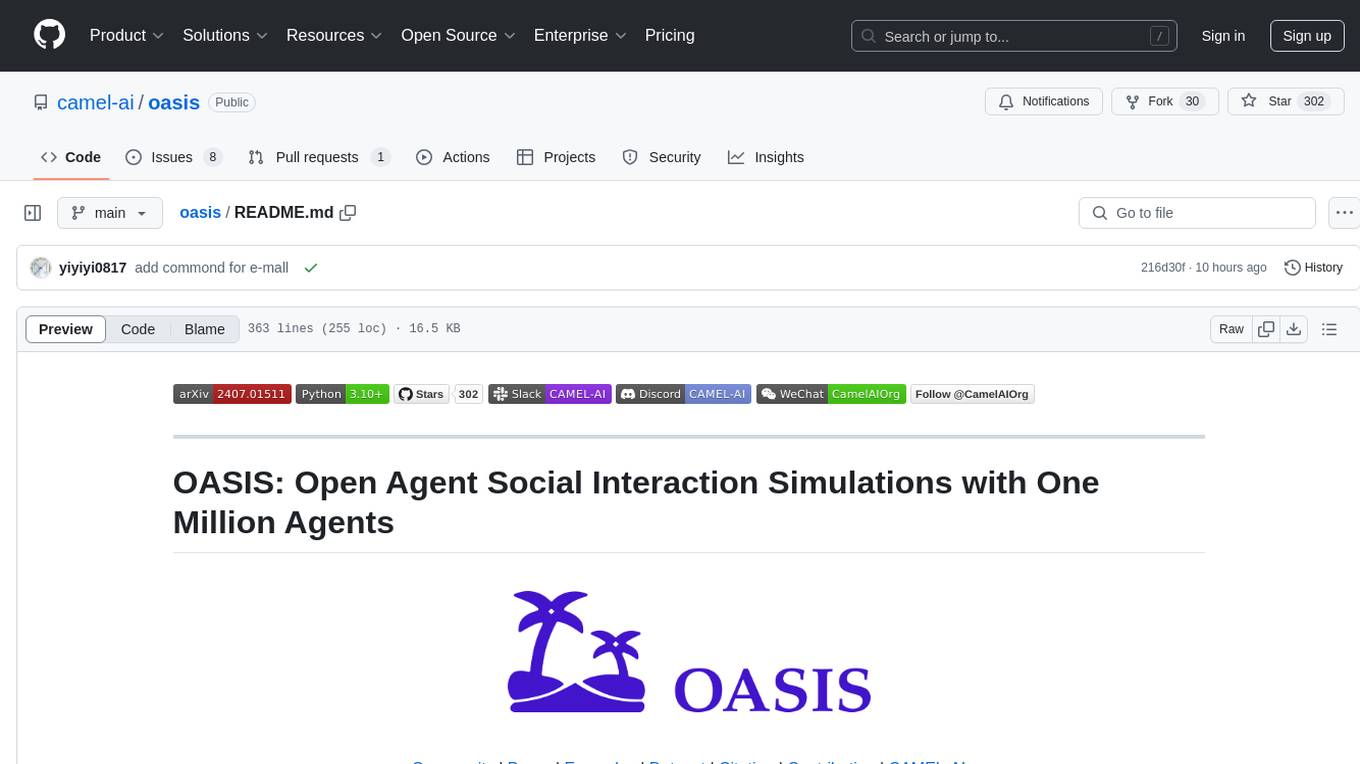
oasis
OASIS is a scalable, open-source social media simulator that integrates large language models with rule-based agents to realistically mimic the behavior of up to one million users on platforms like Twitter and Reddit. It facilitates the study of complex social phenomena such as information spread, group polarization, and herd behavior, offering a versatile tool for exploring diverse social dynamics and user interactions in digital environments. With features like scalability, dynamic environments, diverse action spaces, and integrated recommendation systems, OASIS provides a comprehensive platform for simulating social media interactions at a large scale.
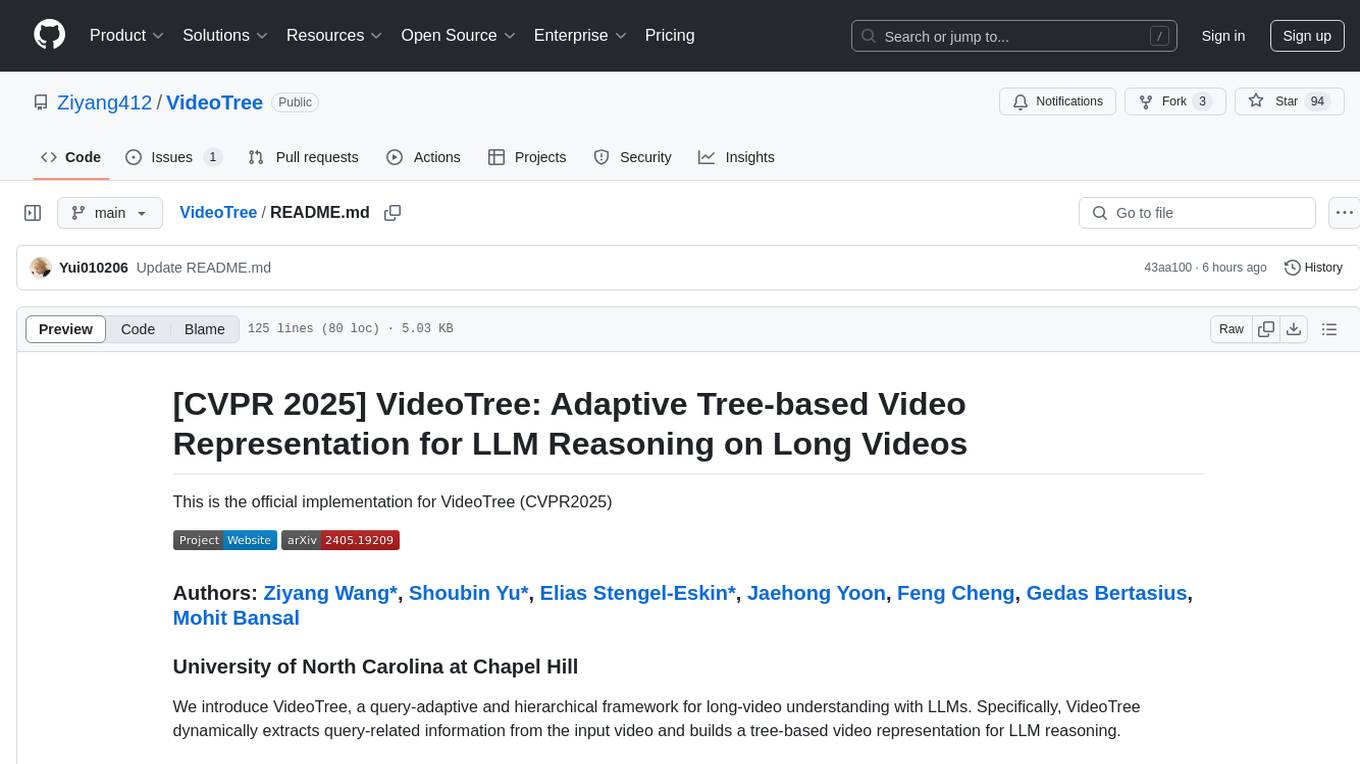
VideoTree
VideoTree is an official implementation for a query-adaptive and hierarchical framework for understanding long videos with LLMs. It dynamically extracts query-related information from input videos and builds a tree-based video representation for LLM reasoning. The tool requires Python 3.8 or above and leverages models like LaViLa and EVA-CLIP-8B for feature extraction. It also provides scripts for tasks like Adaptive Breath Expansion, Relevance-based Depth Expansion, and LLM Reasoning. The codebase is being updated to incorporate scripts/captions for NeXT-QA and IntentQA in the future.

onnxruntime-genai
ONNX Runtime Generative AI is a library that provides the generative AI loop for ONNX models, including inference with ONNX Runtime, logits processing, search and sampling, and KV cache management. Users can call a high level `generate()` method, or run each iteration of the model in a loop. It supports greedy/beam search and TopP, TopK sampling to generate token sequences, has built in logits processing like repetition penalties, and allows for easy custom scoring.
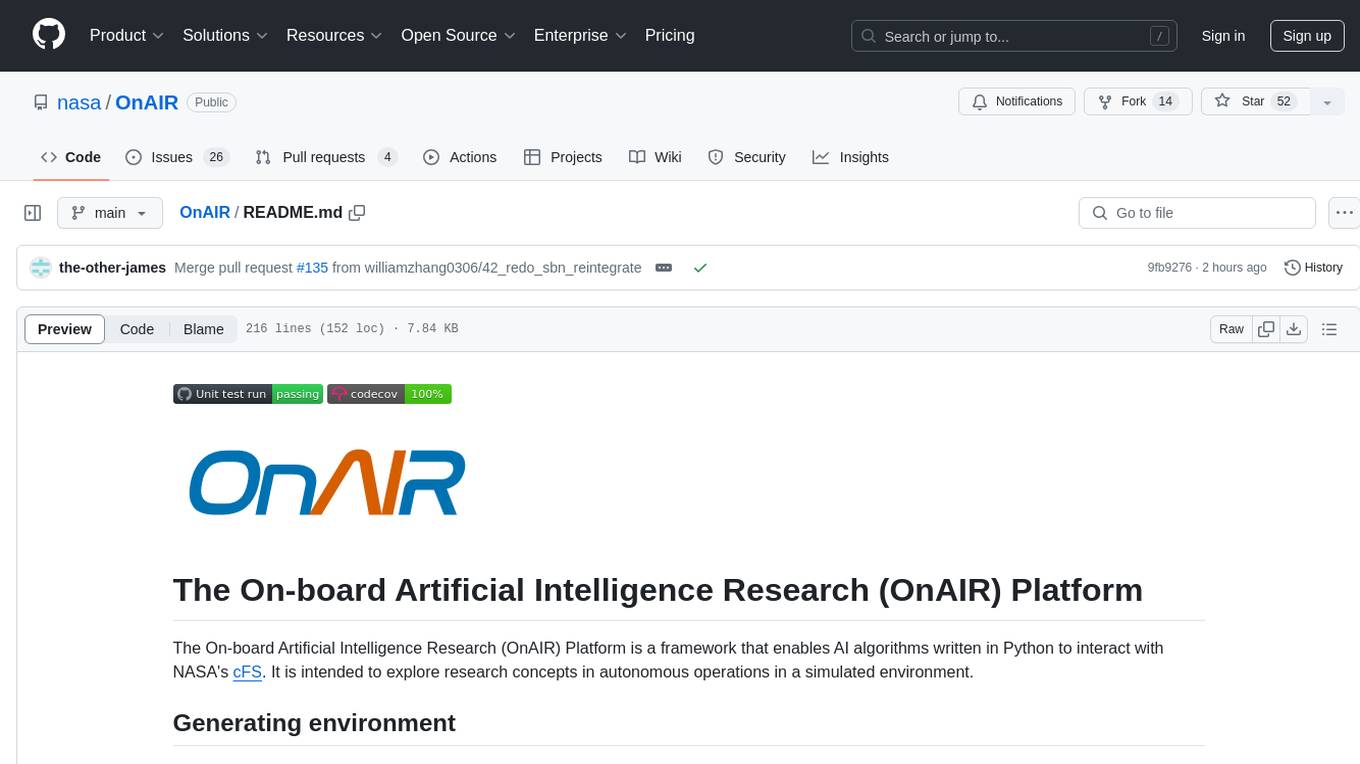
OnAIR
The On-board Artificial Intelligence Research (OnAIR) Platform is a framework that enables AI algorithms written in Python to interact with NASA's cFS. It is intended to explore research concepts in autonomous operations in a simulated environment. The platform provides tools for generating environments, handling telemetry data through Redis, running unit tests, and contributing to the repository. Users can set up a conda environment, configure telemetry and Redis examples, run simulations, and conduct unit tests to ensure the functionality of their AI algorithms. The platform also includes guidelines for licensing, copyright, and contributions to the repository.
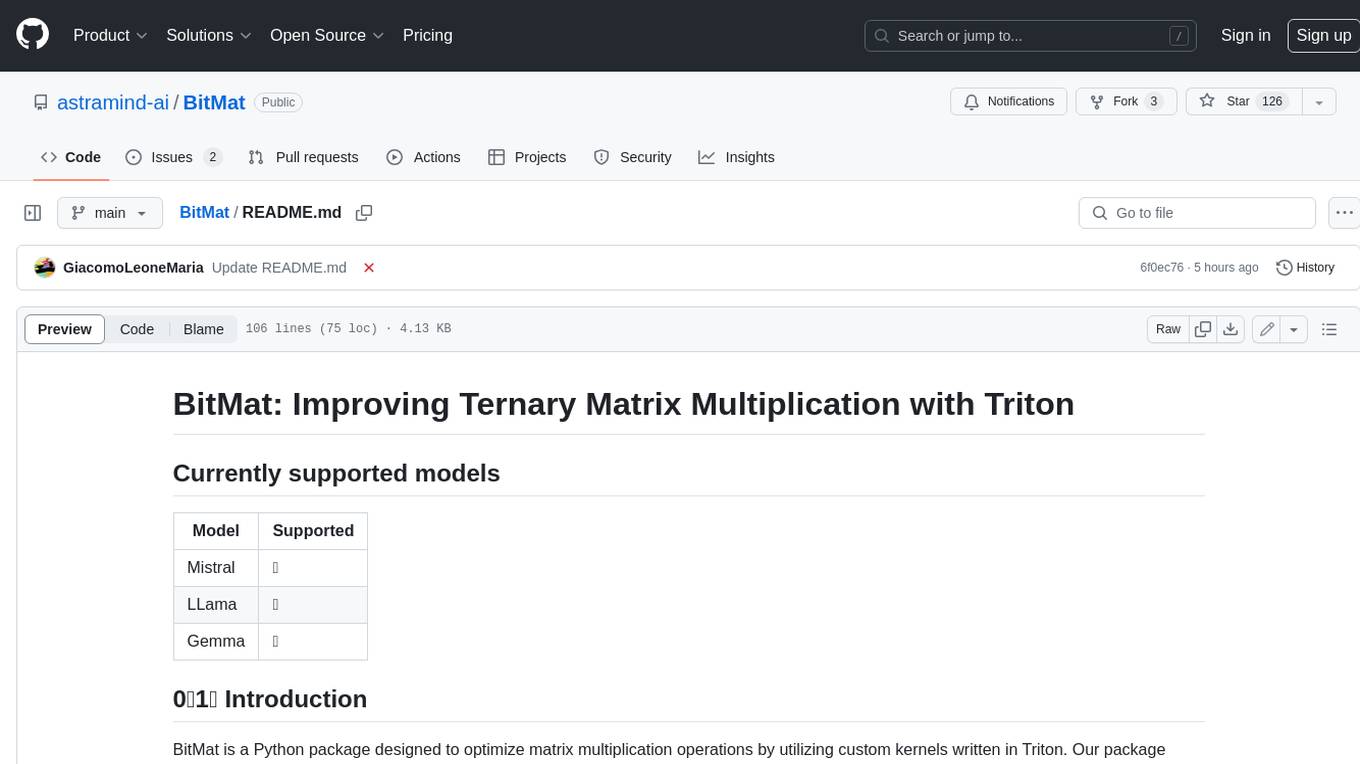
BitMat
BitMat is a Python package designed to optimize matrix multiplication operations by utilizing custom kernels written in Triton. It leverages the principles outlined in the "1bit-LLM Era" paper, specifically utilizing packed int8 data to enhance computational efficiency and performance in deep learning and numerical computing tasks.
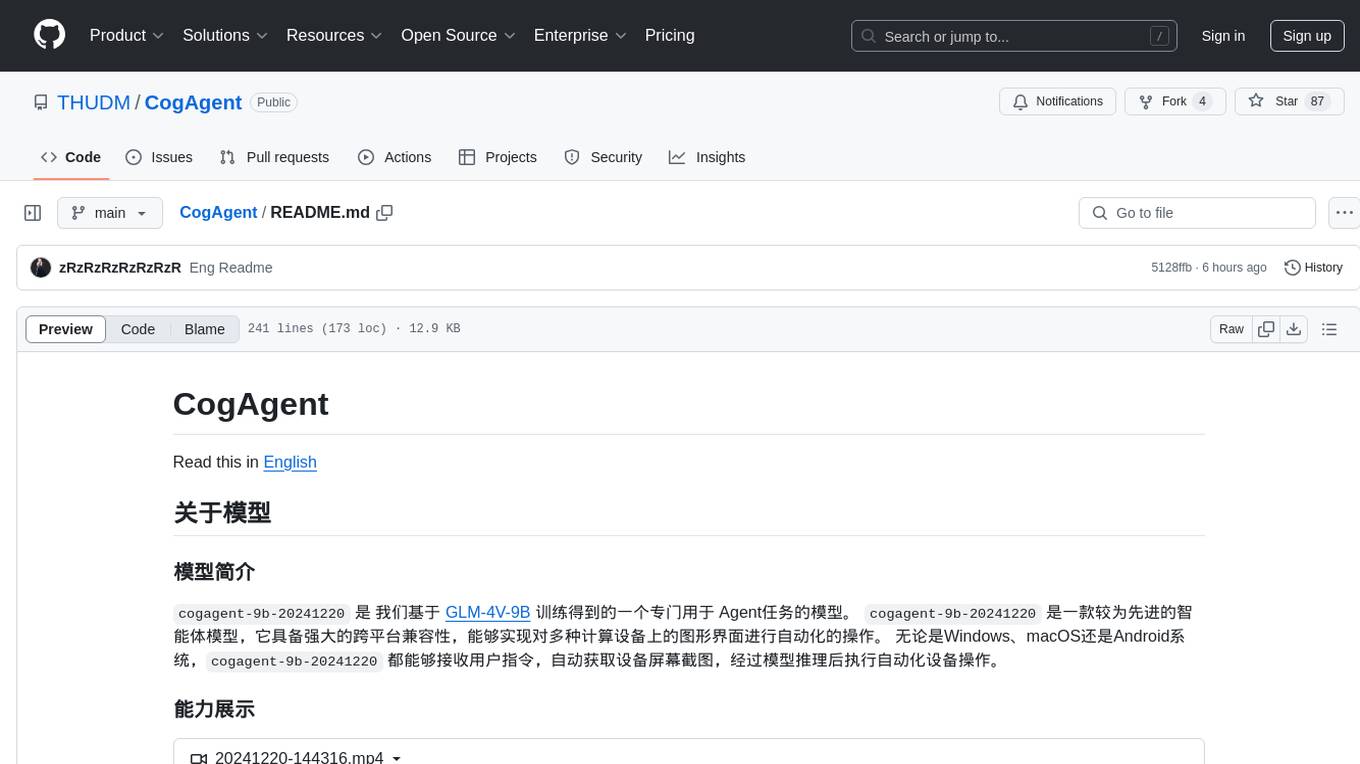
CogAgent
CogAgent is an advanced intelligent agent model designed for automating operations on graphical interfaces across various computing devices. It supports platforms like Windows, macOS, and Android, enabling users to issue commands, capture device screenshots, and perform automated operations. The model requires a minimum of 29GB of GPU memory for inference at BF16 precision and offers capabilities for executing tasks like sending Christmas greetings and sending emails. Users can interact with the model by providing task descriptions, platform specifications, and desired output formats.
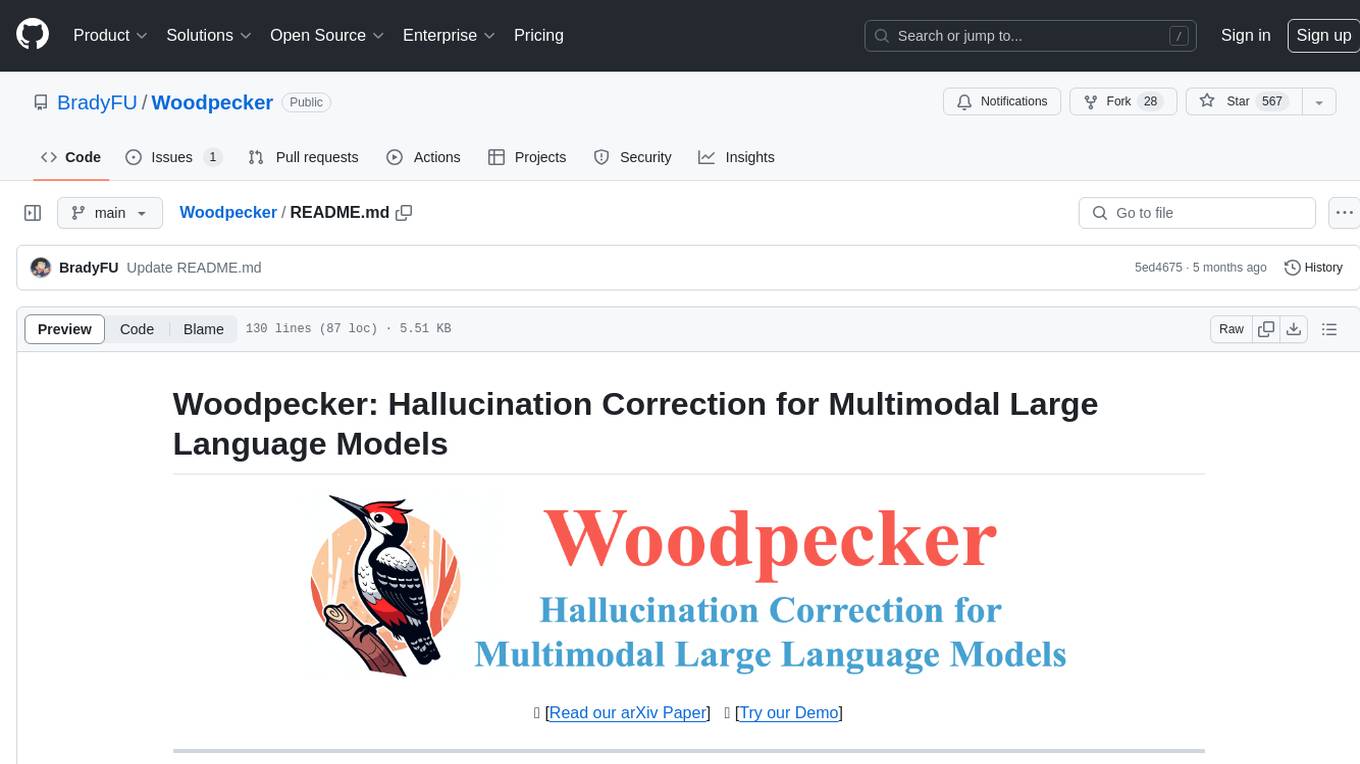
Woodpecker
Woodpecker is a tool designed to correct hallucinations in Multimodal Large Language Models (MLLMs) by introducing a training-free method that picks out and corrects inconsistencies between generated text and image content. It consists of five stages: key concept extraction, question formulation, visual knowledge validation, visual claim generation, and hallucination correction. Woodpecker can be easily integrated with different MLLMs and provides interpretable results by accessing intermediate outputs of the stages. The tool has shown significant improvements in accuracy over baseline models like MiniGPT-4 and mPLUG-Owl.
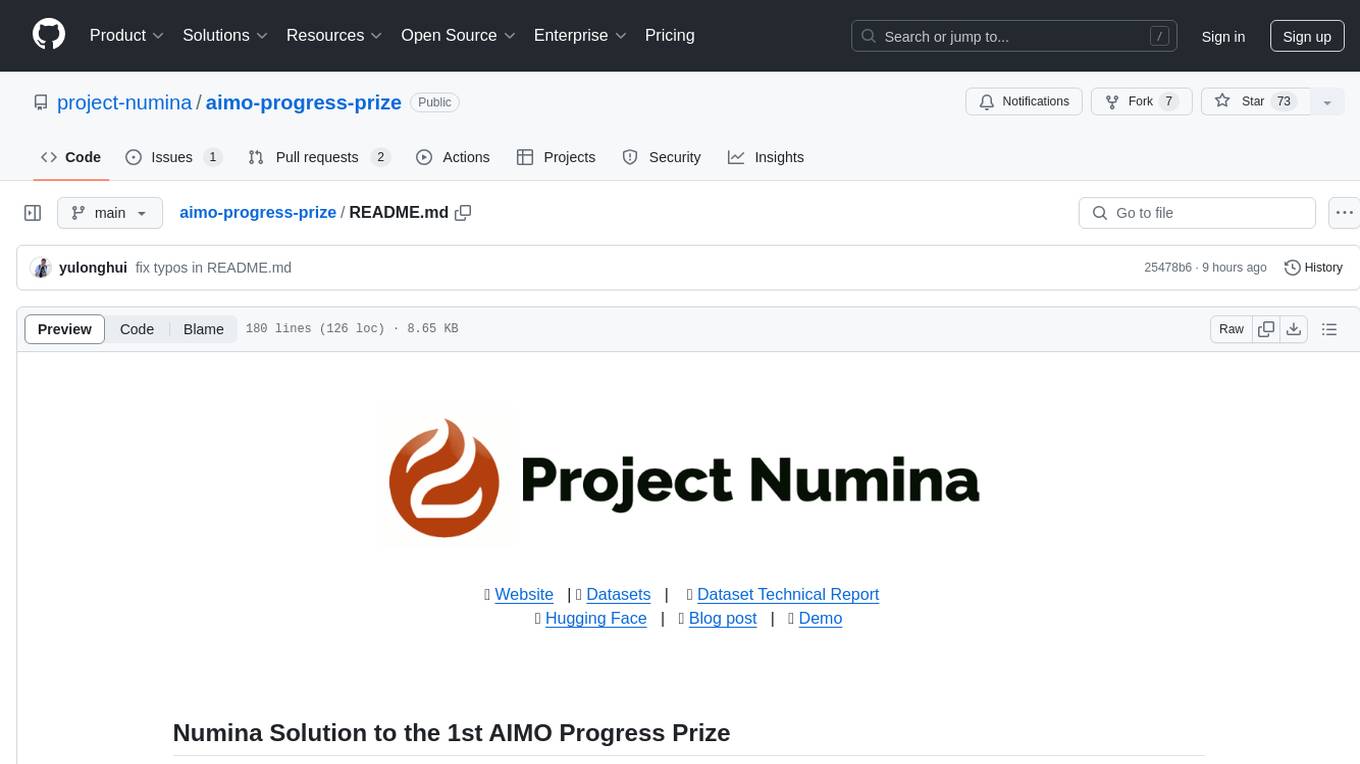
aimo-progress-prize
This repository contains the training and inference code needed to replicate the winning solution to the AI Mathematical Olympiad - Progress Prize 1. It consists of fine-tuning DeepSeekMath-Base 7B, high-quality training datasets, a self-consistency decoding algorithm, and carefully chosen validation sets. The training methodology involves Chain of Thought (CoT) and Tool Integrated Reasoning (TIR) training stages. Two datasets, NuminaMath-CoT and NuminaMath-TIR, were used to fine-tune the models. The models were trained using open-source libraries like TRL, PyTorch, vLLM, and DeepSpeed. Post-training quantization to 8-bit precision was done to improve performance on Kaggle's T4 GPUs. The project structure includes scripts for training, quantization, and inference, along with necessary installation instructions and hardware/software specifications.
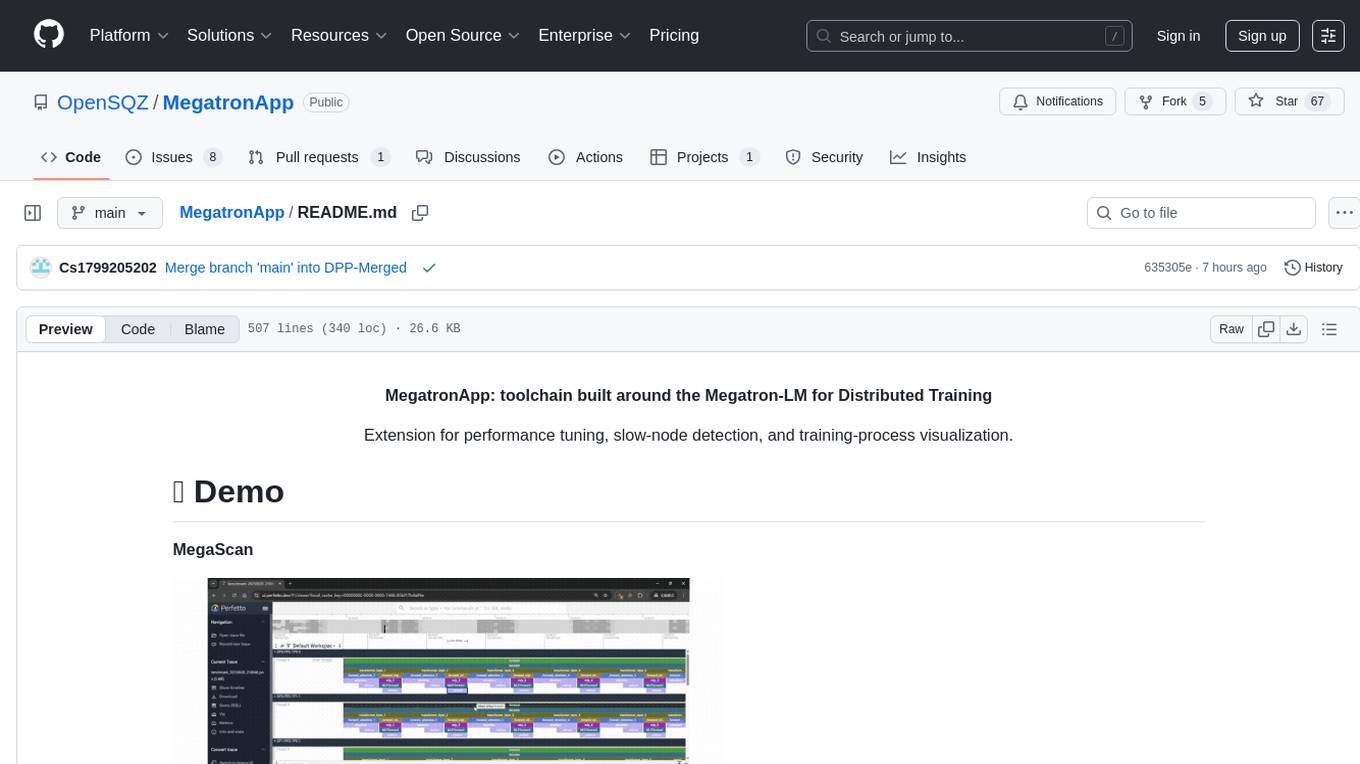
MegatronApp
MegatronApp is a toolchain built around the Megatron-LM training framework, offering performance tuning, slow-node detection, and training-process visualization. It includes modules like MegaScan for anomaly detection, MegaFBD for forward-backward decoupling, MegaDPP for dynamic pipeline planning, and MegaScope for visualization. The tool aims to enhance large-scale distributed training by providing valuable capabilities and insights.
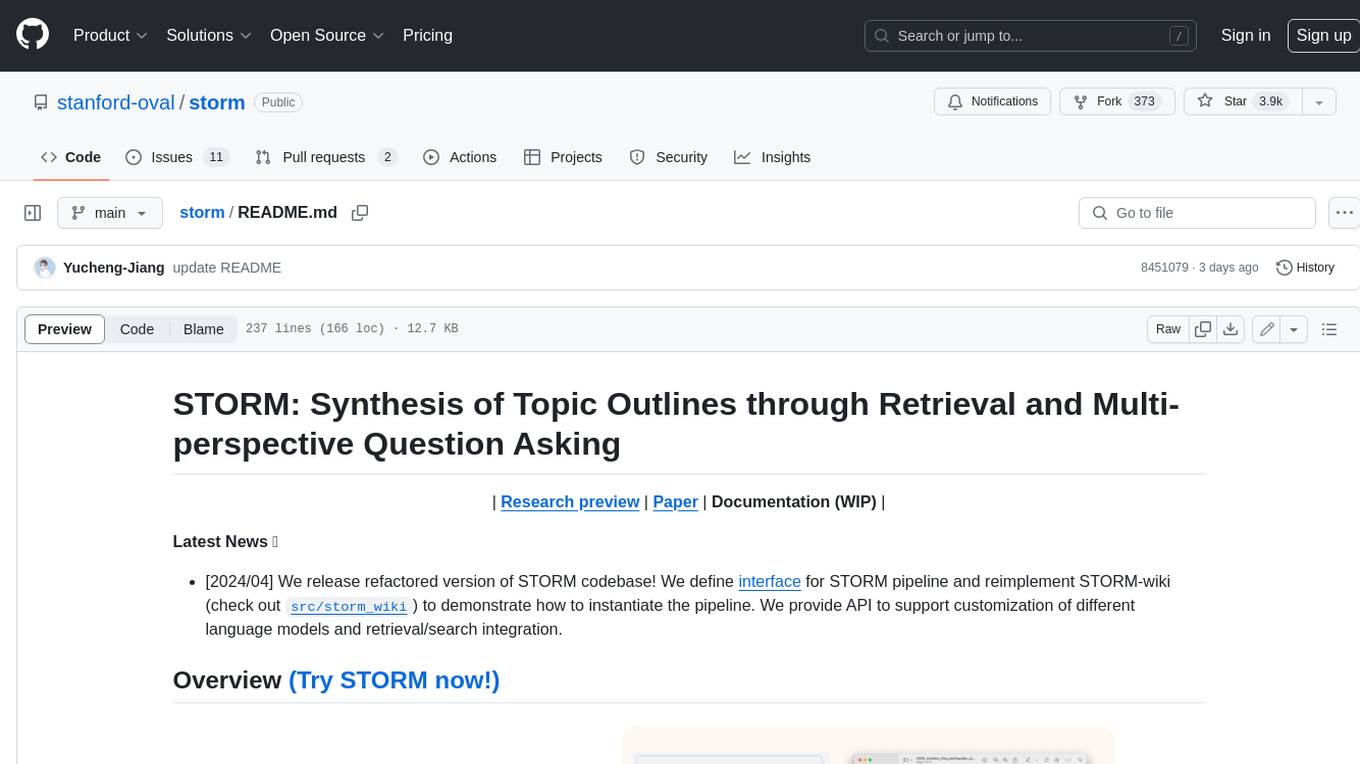
storm
STORM is a LLM system that writes Wikipedia-like articles from scratch based on Internet search. While the system cannot produce publication-ready articles that often require a significant number of edits, experienced Wikipedia editors have found it helpful in their pre-writing stage. **Try out our [live research preview](https://storm.genie.stanford.edu/) to see how STORM can help your knowledge exploration journey and please provide feedback to help us improve the system 🙏!**
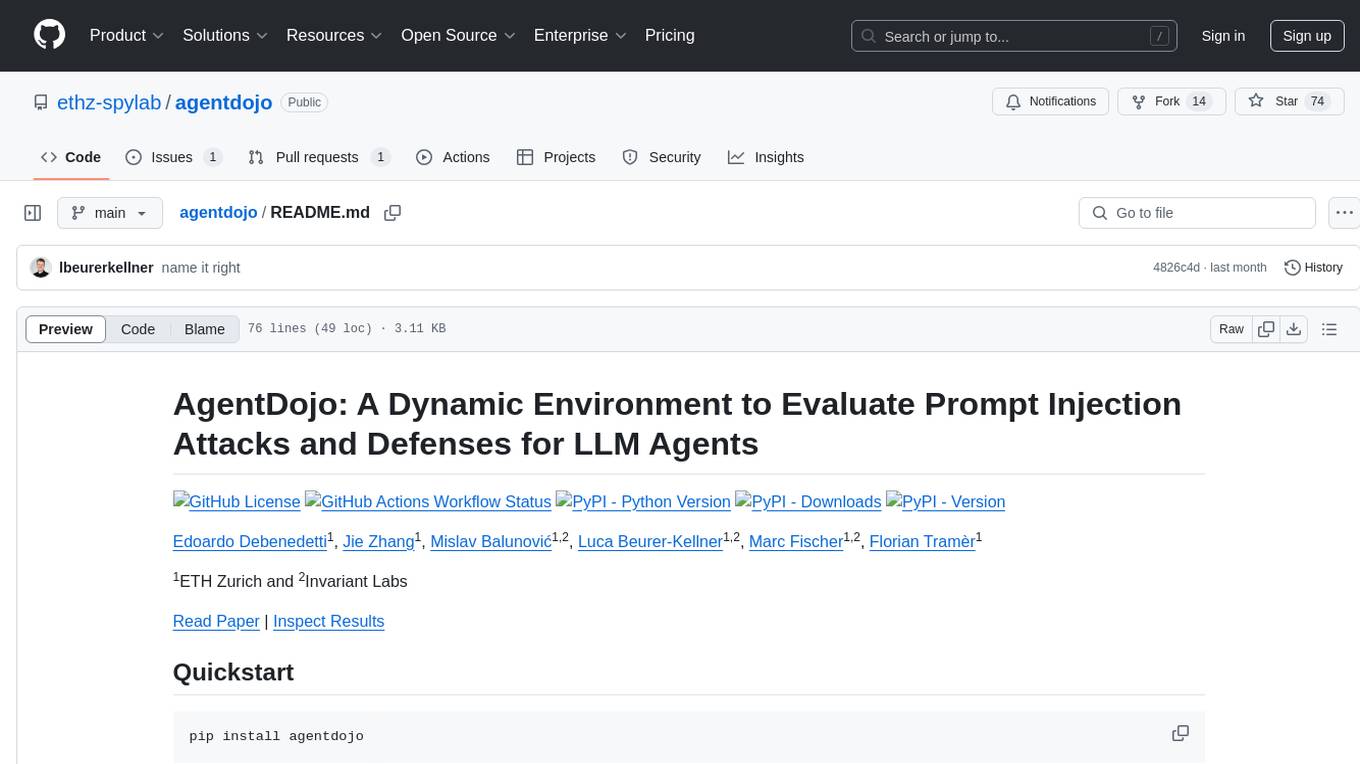
agentdojo
AgentDojo is a dynamic environment designed to evaluate prompt injection attacks and defenses for large language models (LLM) agents. It provides a benchmark script to run different suites and tasks with specified LLM models, defenses, and attacks. The tool is under active development, and users can inspect the results through dedicated documentation pages and the Invariant Benchmark Registry.
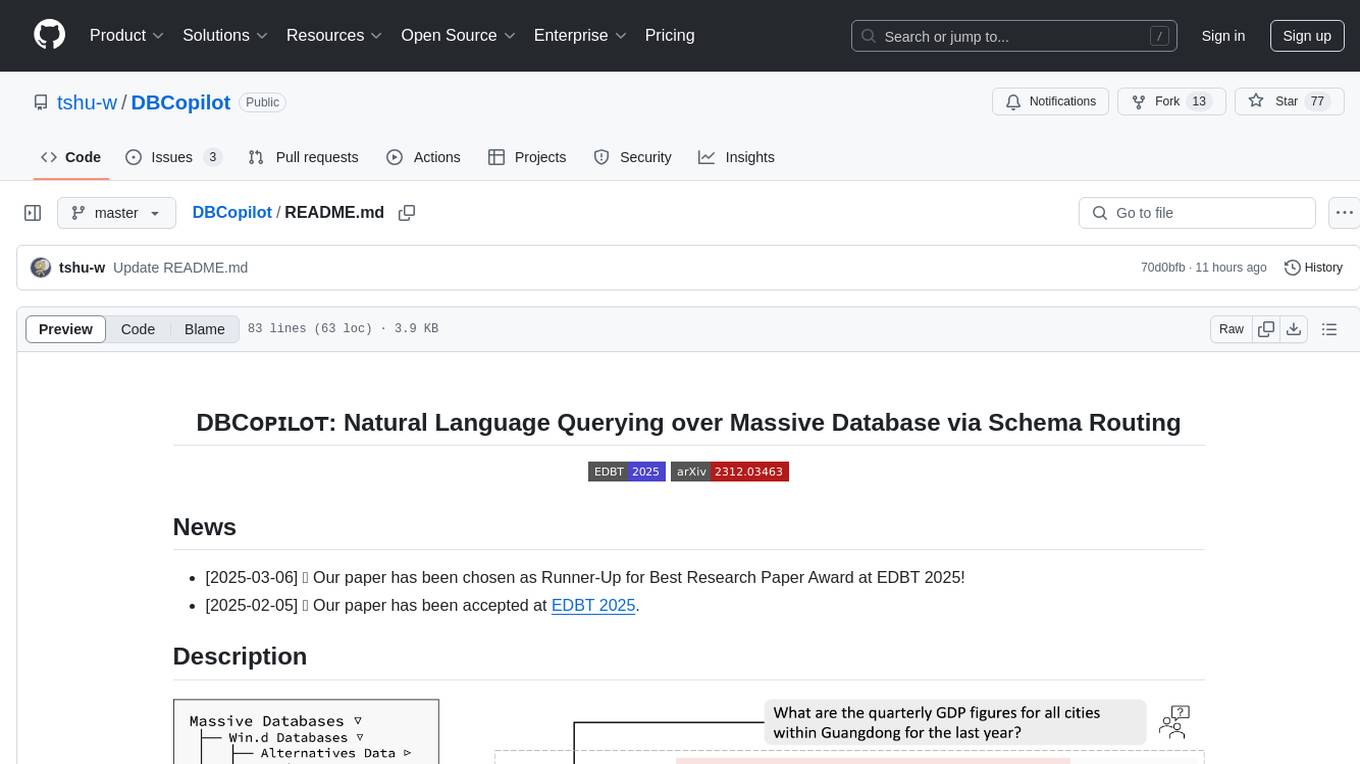
DBCopilot
The development of Natural Language Interfaces to Databases (NLIDBs) has been greatly advanced by the advent of large language models (LLMs), which provide an intuitive way to translate natural language (NL) questions into Structured Query Language (SQL) queries. DBCopilot is a framework that addresses challenges in real-world scenarios of natural language querying over massive databases by employing a compact and flexible copilot model for routing. It decouples schema-agnostic NL2SQL into schema routing and SQL generation, utilizing a lightweight differentiable search index for semantic mappings and relation-aware joint retrieval. DBCopilot introduces a reverse schema-to-question generation paradigm for automatic learning and adaptation over massive databases, providing a scalable and effective solution for schema-agnostic NL2SQL.
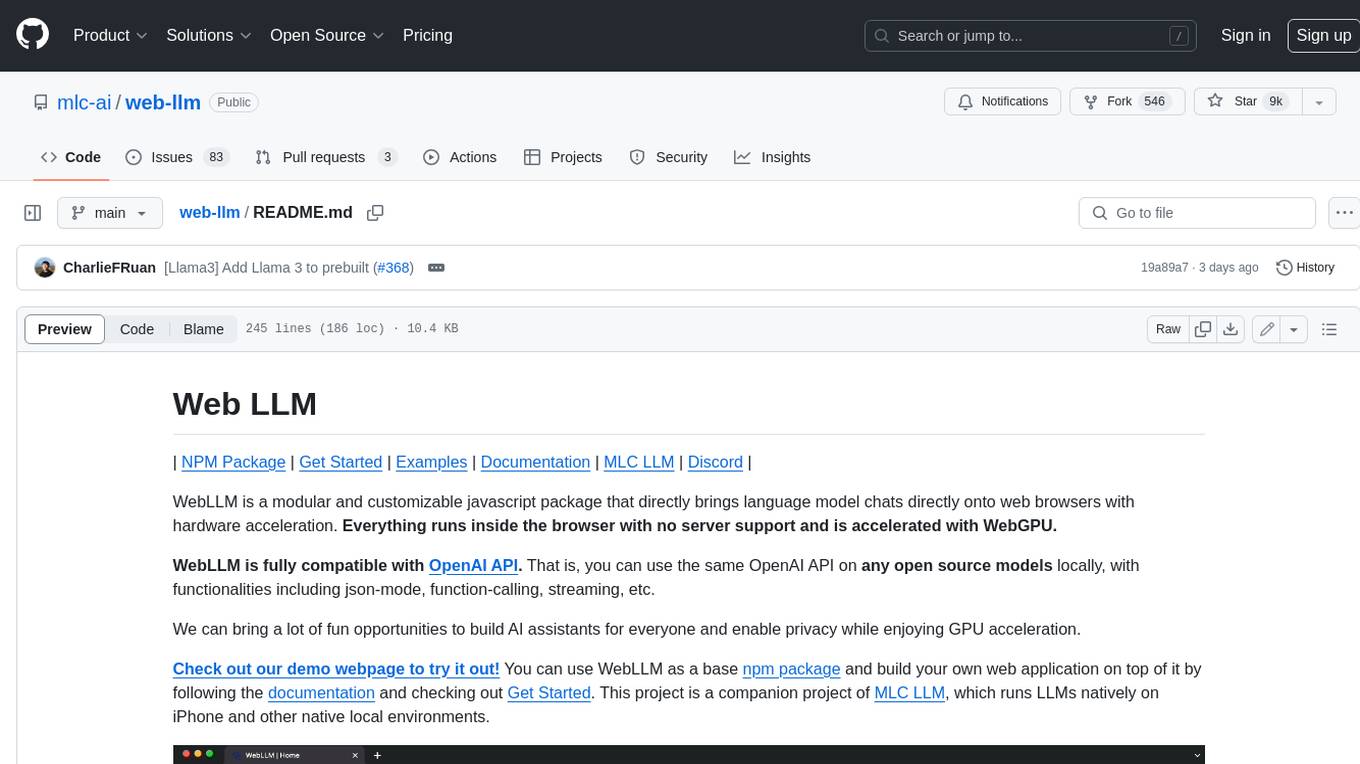
web-llm
WebLLM is a modular and customizable javascript package that directly brings language model chats directly onto web browsers with hardware acceleration. Everything runs inside the browser with no server support and is accelerated with WebGPU. WebLLM is fully compatible with OpenAI API. That is, you can use the same OpenAI API on any open source models locally, with functionalities including json-mode, function-calling, streaming, etc. We can bring a lot of fun opportunities to build AI assistants for everyone and enable privacy while enjoying GPU acceleration.
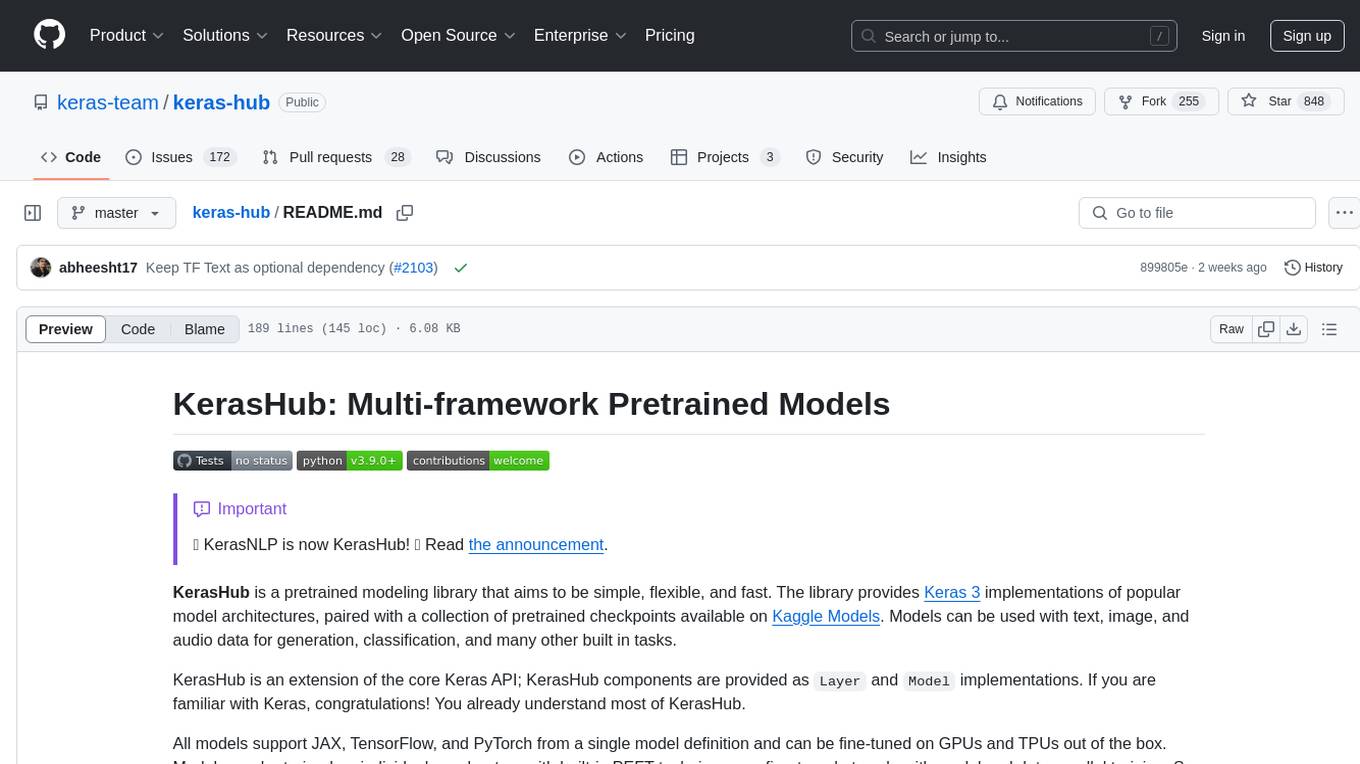
keras-hub
KerasHub is a pretrained modeling library that provides Keras 3 implementations of popular model architectures with pretrained checkpoints. It supports text, image, and audio data for generation, classification, and other tasks. Models are compatible with JAX, TensorFlow, and PyTorch, and can be fine-tuned on GPUs and TPUs. KerasHub components are provided as Layer and Model implementations, extending the core Keras API.
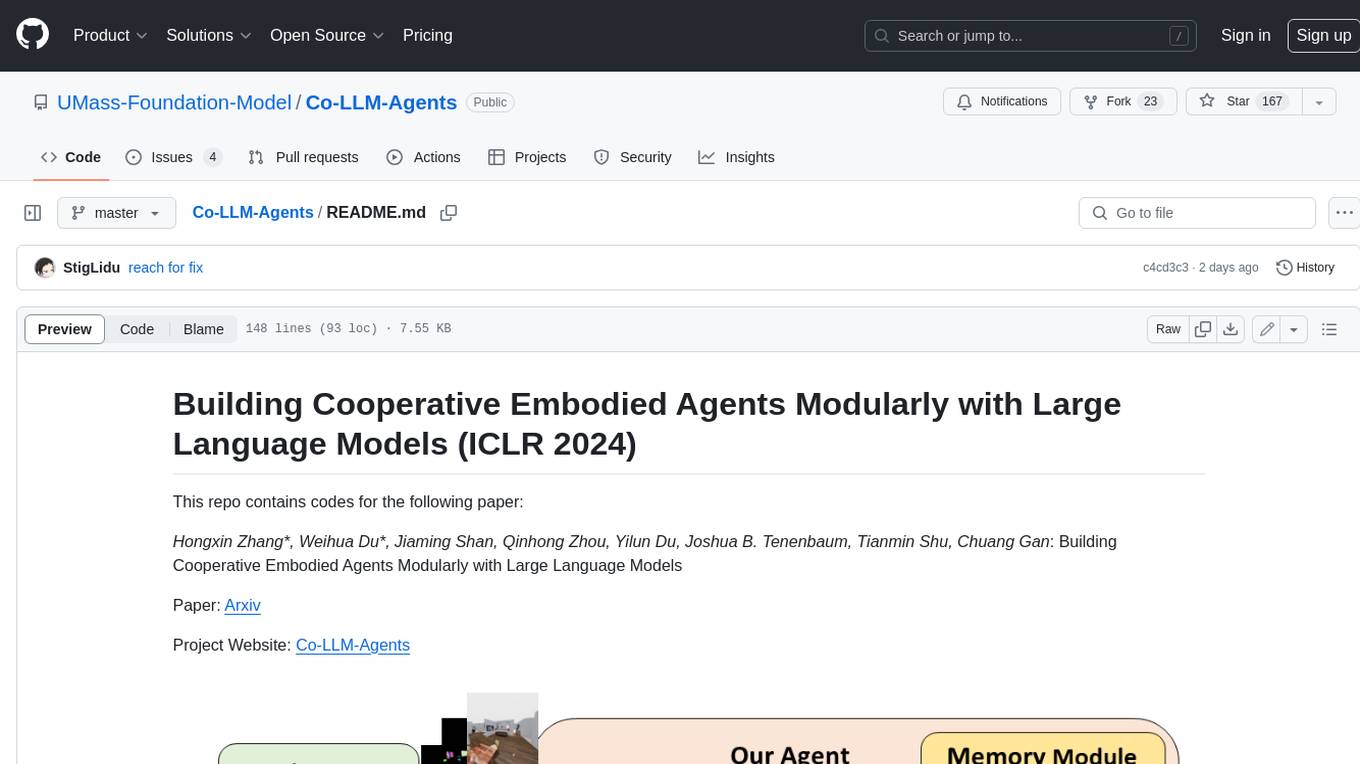
Co-LLM-Agents
This repository contains code for building cooperative embodied agents modularly with large language models. The agents are trained to perform tasks in two different environments: ThreeDWorld Multi-Agent Transport (TDW-MAT) and Communicative Watch-And-Help (C-WAH). TDW-MAT is a multi-agent environment where agents must transport objects to a goal position using containers. C-WAH is an extension of the Watch-And-Help challenge, which enables agents to send messages to each other. The code in this repository can be used to train agents to perform tasks in both of these environments.
For similar tasks

tensorrtllm_backend
The TensorRT-LLM Backend is a Triton backend designed to serve TensorRT-LLM models with Triton Inference Server. It supports features like inflight batching, paged attention, and more. Users can access the backend through pre-built Docker containers or build it using scripts provided in the repository. The backend can be used to create models for tasks like tokenizing, inferencing, de-tokenizing, ensemble modeling, and more. Users can interact with the backend using provided client scripts and query the server for metrics related to request handling, memory usage, KV cache blocks, and more. Testing for the backend can be done following the instructions in the 'ci/README.md' file.
For similar jobs

weave
Weave is a toolkit for developing Generative AI applications, built by Weights & Biases. With Weave, you can log and debug language model inputs, outputs, and traces; build rigorous, apples-to-apples evaluations for language model use cases; and organize all the information generated across the LLM workflow, from experimentation to evaluations to production. Weave aims to bring rigor, best-practices, and composability to the inherently experimental process of developing Generative AI software, without introducing cognitive overhead.

LLMStack
LLMStack is a no-code platform for building generative AI agents, workflows, and chatbots. It allows users to connect their own data, internal tools, and GPT-powered models without any coding experience. LLMStack can be deployed to the cloud or on-premise and can be accessed via HTTP API or triggered from Slack or Discord.

VisionCraft
The VisionCraft API is a free API for using over 100 different AI models. From images to sound.

kaito
Kaito is an operator that automates the AI/ML inference model deployment in a Kubernetes cluster. It manages large model files using container images, avoids tuning deployment parameters to fit GPU hardware by providing preset configurations, auto-provisions GPU nodes based on model requirements, and hosts large model images in the public Microsoft Container Registry (MCR) if the license allows. Using Kaito, the workflow of onboarding large AI inference models in Kubernetes is largely simplified.

PyRIT
PyRIT is an open access automation framework designed to empower security professionals and ML engineers to red team foundation models and their applications. It automates AI Red Teaming tasks to allow operators to focus on more complicated and time-consuming tasks and can also identify security harms such as misuse (e.g., malware generation, jailbreaking), and privacy harms (e.g., identity theft). The goal is to allow researchers to have a baseline of how well their model and entire inference pipeline is doing against different harm categories and to be able to compare that baseline to future iterations of their model. This allows them to have empirical data on how well their model is doing today, and detect any degradation of performance based on future improvements.

tabby
Tabby is a self-hosted AI coding assistant, offering an open-source and on-premises alternative to GitHub Copilot. It boasts several key features: * Self-contained, with no need for a DBMS or cloud service. * OpenAPI interface, easy to integrate with existing infrastructure (e.g Cloud IDE). * Supports consumer-grade GPUs.

spear
SPEAR (Simulator for Photorealistic Embodied AI Research) is a powerful tool for training embodied agents. It features 300 unique virtual indoor environments with 2,566 unique rooms and 17,234 unique objects that can be manipulated individually. Each environment is designed by a professional artist and features detailed geometry, photorealistic materials, and a unique floor plan and object layout. SPEAR is implemented as Unreal Engine assets and provides an OpenAI Gym interface for interacting with the environments via Python.

Magick
Magick is a groundbreaking visual AIDE (Artificial Intelligence Development Environment) for no-code data pipelines and multimodal agents. Magick can connect to other services and comes with nodes and templates well-suited for intelligent agents, chatbots, complex reasoning systems and realistic characters.

